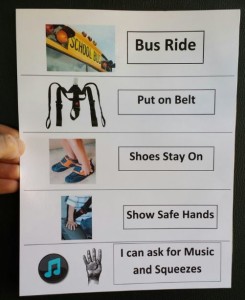It is commonly known that many individuals with autism struggle with transitions, so it should be no surprise that the biggest transition in the day (the bus ride) can end up being very difficult for those on the spectrum. School busses are not what one would refer to as “sensory friendly” and the supports are much more limited than what you would find at home or in school. The bus ride for the child with autism can be very different from what their typically developing peers experience, as is demonstrated in the video below.
There are plenty of examples of what it looks like when things go wrong (Google search videos for “school bus autism” and see what comes up), but we need to stop admiring the problem and start talking about what we can do to properly support kids with autism on the bus. I have spoken at many transportation conferences and to many school districts about this very topic, and there has not been one bus driver who was not willing to make the effort for these kids so long as they had the knowledge and tools to do so. School districts need to look at the bus as the ultimate portable classroom, where strategies are shared and kids feel comfortable and safe just as they do in school. This requires strong collaboration and communication between home, school, and transportation, but it can be the difference for a child on the spectrum. Here are some strategies to consider to get the wheels rolling on this conversation.
 Set a Routine. Students with autism thrive on predictability. Having them sit in the same seat each day or with the same person brings familiarity. Some students can even benefit from a quick check in with the driver or aide before getting on the bus. Having a visual such as what is displayed here can help facilitate the quick, yet key moment in making the ride a successful one.
Set a Routine. Students with autism thrive on predictability. Having them sit in the same seat each day or with the same person brings familiarity. Some students can even benefit from a quick check in with the driver or aide before getting on the bus. Having a visual such as what is displayed here can help facilitate the quick, yet key moment in making the ride a successful one.- Set a Schedule. Be very clear as to how many stops there will be until the student is dropped off. Having them count themselves can empower the student for the future so that they do not have to rely on your constant reassurance.
- Eliminate Fears. There are a lot of moving parts on the bus, some of which can be unnerving for the person with autism. The more that the student knows about their environment, the more comfortable they can become. Educating the student about the bus may need to be the combined work of both the teacher and the driver during the day. Here is an example of a social story that a teacher could review with their student just shortly before getting on the bus.

- Work through change. Whether it be from road construction or a car wreck, bad traffic or a railroad crossing, sometimes a different route has to be taken. If that is the case, talk the student through it starting from the moment you know the change is coming. As long as they know that the same destination will be reached and when, they will have a higher likelihood of tolerating the change.
- Get a sense for the sensory. Come to know your student’s sensitivities and accommodate. If it is the light, let them wear a hoodie over their head or a hat. If it is the noise, make sure they are not right next to the loudest student or allow them to wear headphones. If they need to move, lets make sure they are getting plenty of movement and exercise just before getting on the bus.
- Share the rules. Student with autism need to be shown the rules explicitly and then given a chance to practice them. This again may be better done by teaming with the teacher. This may not eliminate all inappropriate behaviors, but at least you know there is a clearer understanding of what is expected.

- Be Clear with Language. The mind of autism can be very literal, so you if you say something about “brainstorming” a better way to greet a peer, they may just think of this below. Be exact to the point of what you wish to say.

- Keep them busy. The engaged mind often forgets to misbehave. Give them a book, a fidget, a light up toy, anything to keep their mind active and away from any of the possible stressors that come from riding the bus. If they have a tendency to throw items, then play a game of “I Spy” or play some of their favorite music.
- Reinforce, Reinforce, Reinforce! As much as possible, whether it be through praise, tokens, or tickets, let your special rider know when they are doing a great job on the bus. Give them that extra motivation to endure and be sure to share those successes with both the school and home.
- Buckle up for the long ride. Understand that changing behavior is a journey with many stops. So long as safety precautions are in place and progress continues to be seen (however small it might be), trust that the destination will one day be reached. It will require proper steering from the student’s team, but together you will get your student to a better place. Good luck and safe travels!
For inquiries on speaking engagements, email me at patrickmulick@gmail.com.







Thank you for this information. I work with students with ASD and they often have trouble on the bus, so this information is very helpful!
You know worlung and teaching Autism students is my favorite part of my work day. This video is really very helpful.. Thanks for sharing and we will use it this year because we will be recieving 2 new students with Autism this coming sxhool year. Enjoy your summer and once again your presentation was really one of the best trainings i have witnessed.